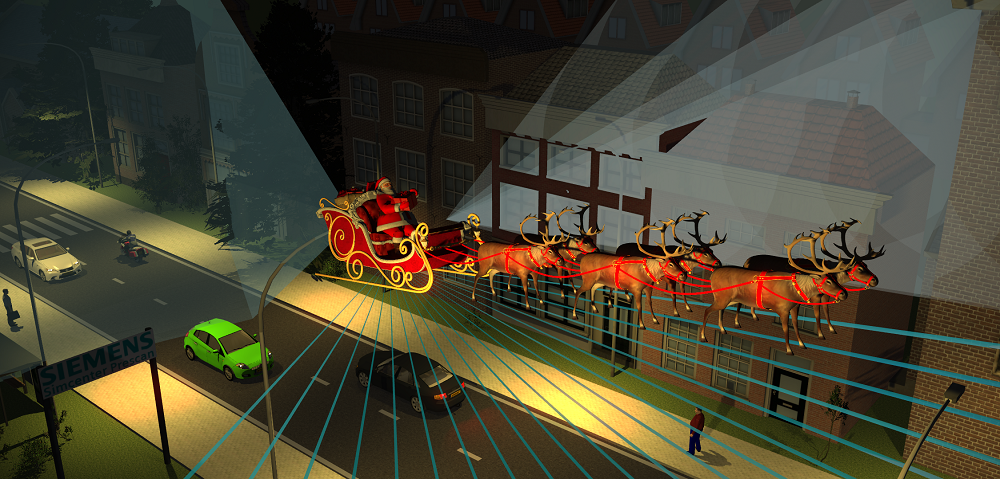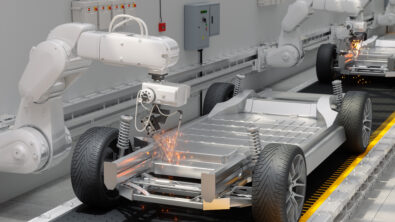What if Santa built an electric, autonomous sleigh?

Christmas Eve is always a special, if exhausting, day each year for Santa Claus. Delivering gifts to children around the world in less than 24 hours is a lot of work. So this year, Santa had an idea to make his holiday duties less stressful for him and his reindeer: using vehicle electrification and autonomous driving technology.
By partnering with Siemens, Santa developed an ambitious plan to exponentially boost the efficiency of his worldwide gift delivery operation.
Here’s how Santa Claus and his team did it:
Electrification of the sleigh
Where could Santa maximize efficiency? While Santa’s reindeer are amazing at their jobs, he doesn’t want to overwork them. So, he considered ways to minimize the burden of flying on his reindeer. His first thought was through electrification. But, how could he build an electric sleigh with optimal performance and a large enough range?
Santa gathered his best engineering elves and tasked them with designing, developing and electrifying his cherry red sleigh. The elves knew that every function and feature in an electric vehicle needed to be electrified and controlled by software.
They chose to simulate, validate and verify the capabilities of the sleigh, make necessary changes and then ensure all the engineering teams had the latest iterations at their fingertips. Getting to full electrification takes a lot of virtual design and analysis, but the benefits were well worth the effort. They were able to develop a re-envisioned sleigh more quickly with simulation then show how a variety of conditions including headwinds, cold weather, altitude, acceleration, weight of presents, and a dash of reindeer magic, would impact battery performance.
With the electrification of the sleigh complete, Santa turned his attention to other opportunities to make his deliveries more efficient.
The autonomous sleigh
Santa then considered the idea of making his sleigh fully autonomous. The autonomy of the sleigh allowed him to focus less on steering and more on higher value tasks, such as organizing the presents.
The new design incorporated special light detection and ranging (LIDAR), radar and camera sensors. These sensors will capture sensor data as the sleigh travels across the sky and landing on countless roofs around the world.
The data from each sensor feeds into an innovative autonomous driving platform based in the North Pole workshop. The result is a consistent, high resolution, 360-degree view of the sleigh’s surroundings. The sleigh’s driving decision AI algorithms and steering actuators nimbly navigate the vehicle as it travels autonomously across the globe.
Once the self-driving sleigh prototype was perfected, Santa wanted to ensure safety and that the sleigh would operate as designed. So, Santa’s engineers looked at super computer-class simulation of the sleigh and environment so to minimize the need for extensive physical prototyping. This dramatically reduced the need for hundreds of millions of logged test miles necessary to demonstrate the safety of the sleigh. The right simulation platform produced highly realistic, physics-based simulations of an unlimited number of potential flying situations and other parameters. Santa can now rely on an autonomous flying system that can travel safely to its destination and land on a variety of rooftops without worrying about a single glass of spilled milk.
Santa could see it all coming together, but he was not quite satisfied with its efficiency. It was time to design one more time-saving feature.
The last mile of delivery
Santa has millions of chimneys to descend and presents to put in place. While all that work is rewarding, it is also time-consuming. So, having implemented autonomous applications for the sleigh, Santa decided to automate the last mile of delivery.
Imagine Santa’s sleigh landing on a single roof in your neighborhood, then deploying tiny autonomous vehicles, or mini sleighs, to deliver presents to all the houses in the area at once.
Santa can dramatically reduce average delivery time and the elves loved this idea.
Testing of the new deployment process in the North Pole commenced. During live experiments, the complex prototypes were tasked with identifying and encountering many hazardous situations — an active fireplace, children who are awake, dogs barking and more. This information was then used to create re-useable and configurable software simulation scenarios. Sleigh-to-sleigh and sleigh-to-city analytics were automatically determined for best routing decisions, ensuring children are asleep before delivering presents and whether battery power will be sufficient to cover the route to the destination and back to the sleigh where they could recharge.
Analytics can now be used to improve fleet utilization and provide insight so that the Christmas delivery program remains efficient and presents are delivered on-time.
What’s Santa doing?
Even with all this automation and analytics, Santa remains the man in charge, and will be ready to take the reins, if needed. Meanwhile, he is focusing on other aspects of the present-delivery system, such as ensuring ample room on his sleigh for more presents, checking his digitalized lists thrice and having the freedom to watch his state-of-the-art system work autonomously with his feet propped up smoking his pipe.
With the help of comprehensive digital twin technology, automation and analytics tools, Santa has accomplished his off-season goal of building an autonomous, electric sleigh and creating a more efficient system when delivering presents around the world.
Happy Holidays to all from Siemens!


